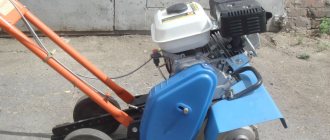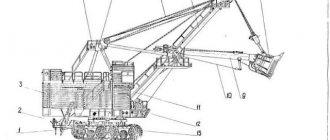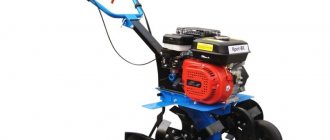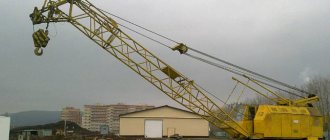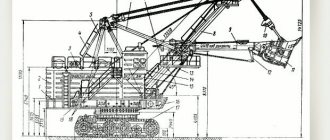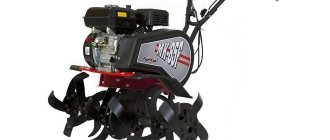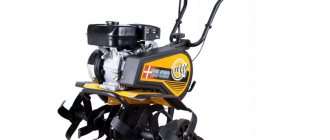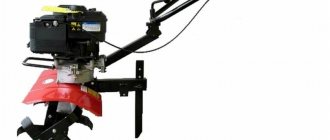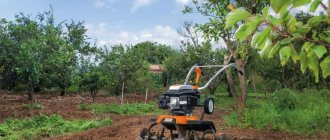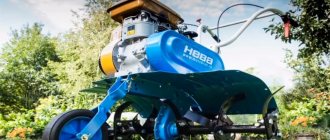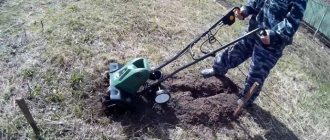Operating principle and maintenance
Before you start using the cultivator, it is necessary to set it up and adjust it. If this is not its primary use, then you will have to clean the device from dirt and organic fragments. Next, the presence of the required parts and their condition are checked, as well as whether something needs to be strengthened or tightened, for example, the seals on the hub. If necessary, faulty parts are replaced with new ones, for which it is always worth having spare parts available. Flat tires are inflated and the bearings are additionally lubricated.
Adjustment of the cultivator must be carried out on a leveled area. During this process, a lining should be placed under the wheels, which will be less than the immersion depth by 2 or 3 centimeters, which disappeared due to the lowering of the wheels
It is important to maintain the same height of both wheels for accurate adjustment and further operation. A lining is also placed under the stand, the thickness of which corresponds to 350 millimeters, to which is added the parameter used for lining under the wheels. At the next stage, the working units are adjusted to the required stroke depth
At this time, the moving device is prepared, after which both components are combined
At the next stage, the working units are adjusted to the required stroke depth. At this time, the moving device is prepared, after which both components are combined.
The process of operation of the KPS steam cultivator occurs as follows: a moving device with an attached cultivator enters the area being treated. The frame is lowered in such a way that the paws penetrate into the soil to the required depth. During this process, the stems and roots of the weeds are cut by the sharp parts of the paws.
The lumps that were on the surface move up the paws, and then break into small fragments as they fall down. Thus, a uniform layer of earth is formed on the surface. Sometimes, in order to crush the soil more intensively, the general scheme is supplemented by the action of tooth harrows placed on the cultivator. By the way, the size of how deep the paws go can be changed using the support wheels. When the latter rise, the impact in depth increases, and when they fall, it decreases. Whether the processing occurs evenly or not can be determined by interacting with the spring on the rod. Compressing it increases the depth of the stroke, and relaxing it, accordingly, decreases it.
It is important to mention that the cultivation itself is first performed across the main treatment, and then perpendicular to the previous approach. The device typically moves in a shuttle motion
Having finished processing the main passes, it is necessary to pay attention and process the turning areas of the site
Handling the cultivator during operation
When operating the cultivator, be sure to keep your limbs away from moving parts of the cultivator. It is better to work in closed shoes: high boots, and even better – boots. Save flip-flops or flip-flops for other purposes, as they increase the risk of injury. It is advisable to wear glasses and gloves when plowing the soil.
After switching on, there is no need to push the cultivator; it is simply pointed in the desired direction. When the unit stops in the ground, rock it slightly from one side to the other, with your little help it will continue to move. To avoid trampling the newly tilled soil, turn the handle and walk next to the plowed strip.
When working with a cultivator on wet soil, large clods are obtained. It is then difficult to loosen the soil, and the soil sticks to the cutters. When the soil is very dry, the depth of cultivation is sharply reduced. In this case, the strip is first passed at a shallow depth, repeating its passage to the required depth. Therefore, it is best to work with moderately moist soil. The low speed of movement of the cultivator at high speeds of the cutter allows for more thorough cultivation of the soil.
When the ground is soft, an anchor attachment is best for loosening the soil. With a cultivator it is more convenient to move in rows or zigzags.
Plowed area with a cultivator
Some tips on how to properly handle the cultivator
- If there are a lot of small pebbles in the area, work at lower speeds.
- The walk-behind tractor will serve for a long time with regular maintenance. Changing the oil, cleaning the unit, sharpening the cutters is the key to the “health” of your cultivator. You can't skimp on oil. When pouring inappropriate oil during operation, a solid sediment is formed, which clogs the unit components. As a result, the cultivator may fail. And then the cost of repairing it will significantly exceed the savings that you managed to achieve on changing the oil. This also applies to gasoline.
- Important : Filling with fuel is only possible when the engine is stopped and cooled down. After refueling, check the fuel tank for leaks.
- All adjustments should also be carried out with the engine turned off.
- If you feel vibration during operation, this is a signal that a problem has begun. It is worth stopping the engine, finding the cause (most likely the parts are loose) and eliminating it.
- Row spacing in the garden is not always ideal. In order not to damage the plants, you can reduce the cultivation strip by removing the external cutters.
- Powerful motor cultivators can move not only forward, but also backward. If it is necessary to change the direction of movement, pause until the cutters stop.
- The cultivator should move smoothly and evenly. If it buries itself in the ground, then it is necessary to adjust the position of the wheels or swap the cutters.
- After using the unit, wipe all metal parts with a cloth. If necessary, rinse the cutters and then wipe them dry. Safety precautions when working with a cultivator
Design and components of the KPS-4 cultivator
The cultivator consists of the following components: flat welded frame; pneumatic support wheels (2 pcs.), equipped with screw mechanisms to regulate the depth of travel of the working bodies; beds with lifting and pressing rods: 4 – short and 8 – long; device for hanging 4-tooth harrows; a hydraulic device that lifts the working parts to the transport position.
The rows, running wheels and side bars of the rig are attached to a flat welded rectangular frame. The support running wheels are mounted on the axle shafts of the brackets, the outer end of each of which is connected to the side beam of the tongue by a screw mechanism for adjusting the depth of travel of the working bodies. On the front part of the frame, its towed part, the drawbar, is hinged. It is equipped with a wheel adjustment mechanism and a hydraulic cylinder. The hydraulic cylinder is located on the bracket and is connected by a hinge to the central beam of the hitch. It serves to translate the raising of the frame with the cultivator beams during transportation.
On each of the short rows, one lancet paw is mounted, and on each of the long ones, with the help of double holders, there are two ripping paws. The paw stand is attached to the beam with a bolt, a holder and a bar. Adjustment bolt; it holds the paw stand in a given position. The KPS-4 cultivator is equipped with pointed universal shares with a working width of 270 and 330 mm, respectively, 8 and 16 pieces each. Typically, pointed paws are attached to the beams in two rows. In the front row, paws with a width of 220 or 270 mm are located on short beams, and in the back row, on long beams, paws with a width of 270 or 330 mm are located.
GOST standards No. 23.2.164-87 for KPS-4 cultivators require the use of universal paws of size 3 with a grip width of 270 mm and a metal thickness of 5 mm; as well as size 5 (H=330 mm, S=6 mm). According to their shape, the paws of the KPS-4 cultivator are, in addition to pointed (knife-shaped or spear-shaped), also chisel-shaped, spring-shaped (on spring struts); and disks are also used. Chisel-shaped paws are used to loosen the soil. Spring paws are used to eliminate perennial weeds and pull out their rhizomes; for combing out root weeds: sow thistle, field bindweed, etc.; for lands with high humidity of the top layer.
The discs contribute to the destruction of dry soil crust, help to loosen and fluff up the soil during the growing season, without causing harm to crops, but at the same time destroying weeds. The toes of ripper paws can be single-sided or double-sided. Double-sided socks rotate 180 degrees after significant wear on one end.
The device for additional hanging of harrows is a structure assembled from four rods with rods, leashes and four guy wires. Tooth harrows are attached by links to the device with hooks and loops of leads. Guys or chains are secured with staples to the ends of the rods.
They are connected by locks to harrow links. In cases of transportation over significant distances, the harrow links are laid on the cultivator frame bars, and they are not separated by leads; and each of the links is securely attached to the frame.
Continuous tillage cultivator KPS-4U / 5U
For pre-sowing soil cultivation and fallow care at operating speeds of 12 km/h. Suitable for use in all soil and climatic zones of Russia with soil moisture of 8-28% and hardness of 0.4 - 1.6 mPa in horizons from 0 to 15 cm in fields with flat and undulating terrain, except for zones subject to wind erosion.
- The frame structure has been strengthened due to the use of a more durable pipe 80x80x5.
- The surface of the hinge joint between the beam and the frame has been doubled, which reduces wear on the beams, reduces deflection during operation and ensures maximum overlap area of the paws.
- The bars for attaching the holder have been strengthened (14mm).
- An additional support for the wheel bracket has been removed.
- Separate axles are used in the articulated connection of the frame, the linkage and the wheel brackets, which ensures ease of assembly and disassembly of the cultivator.
- The strength of the hinge connection between the tongue and the frame and bracket has been increased.
- The one-sided short beds near the bypass beds were lengthened in order to eliminate undercutting of the cultivator tires by the paws (330mm).
- The bypass row has been expanded to eliminate clogging of the cultivator wheels with wet soil and plant debris.
| Parameter/Model | KPS-4U | KPS-5U |
| Productivity, ha/h | 4,65 | 5,73 |
| Working width (working), m | 3,9 | 4,9 |
| Processing depth, no more, cm | 12 | 12 |
| Number of working bodies, pcs | 16 | 20 |
| Structural weight, kg | 940 | 1000 |
| Required tractor class/power for aggregation, | 1,4-2,0 | 1,4-2,0 |
| Working dimensions (LxWxH) without tooth harrows, mm | 4980x4095x950 | 4980x5090x950 |
| Ground clearance, mm | 300 | 300 |
| Frame | all-welded | all-welded |
| Number of racks/disks/cases, pcs. | 16 | 20 |
| Distance between racks/disks/cases, cm | 25 | 25 |
| Operating speed, km/h | 10-12 | 10-12 |
| Transport speed, km/h | 15 | 15 |
KPS 04.000 Device for attaching tooth harrows is designed for attaching tooth harrows to the KPS-4U cultivator and for additional crumbling and leveling of the soil
| Parameter | Meaning |
| Productivity, ha/h | 4,65 |
| Working width (working), m | 3,9 |
| Processing depth, no more, cm | 4-8 |
| Number of attached tooth harrows, pcs. | 4 |
| Pitch of longitudinal rows of teeth, cm | 4,5 |
| Working tooth size length/thickness, mm | 160/square 16 |
| Structural weight (without tine harrows), kg | 121 |
| Working dimensions (without tooth harrows) (LxWxH), mm | 2280 x 3570 x 690 |
| Optimal operating speed, km/h | 10 |
| Maximum operating speed, km/h | 12 |
| Maximum transport speed, km/h | 15 |
KPS 08.000 Rotary harrow is designed for compacting and leveling the field surface while simultaneously combing out weeds.
Cultivator KPS-4: technical characteristics and device
Continuous cultivation should be used to completely destroy various weeds and loosen the soil without additional wrapping it in preparation for sowing and caring for fallows.
The loosening procedure helps to preserve and accumulate moisture and many nutrients. Cultivators used for continuous soil cultivation are divided into the following types: steam, garden, forest and anti-erosion.
This article will examine one of the many types of cultivators and describe in detail its structure and operating principle.
Scheme and structure of the KPS-4 cultivator
Below we provide a diagram of the KPS-4 cultivator
The KPS-4 steam high-speed cultivator is used for multi-layer loosening of the soil before sowing and destruction of various types of weeds, while harrowing occurs at a speed of up to 12 km/h.
This model is available in two versions: trailed and mounted; in addition, there is a device for attaching additional harrows.
The working parts of the cultivator are universal lancet-type paws, they have a grip width of 27 cm or 33 cm, the second element is the loosening paws based on a rigid stand, the grip width is from 35 to 65 mm, the last element is spring loosening paws with a grip width of 5 cm.
The tine stands are mounted on special rows, which are hingedly attached to the cultivator frame. The universal pointed tines are arranged in two rows in a staggered pattern. Paws 27 cm wide are attached in the front row of the bed, and in the secondary row, paws 33 cm wide are mounted on a long row.
If it is necessary to cultivate the soil to a depth of up to 25 cm, you need to use loosening paws, and to loosen the soil to a depth of up to 16 cm and “comb out” root weeds, you need to use spring loosening paws. On short rows, one ripper paw is attached, and on long rows, with the help of double holders, two paws are attached.
The T-150 and T-150K tractors are equipped with two or three cultivators with the SP-11 hitch or the central section of the SP-16 hitch, and with the K-701 - four with the SP-16 hitch. Cultivators in row units are connected to each other by hinges, which creates stability and good contour following in the vertical transverse plane.
When preparing the unit for operation, the tractor linkage mechanism is installed in the uppermost position, and the tow bracket is installed in the rear forks of the yokes. A harness is put on it.
To work with three or four cultivators, it is necessary to deploy the side wings of the special SP-16 hitch and mark the connection points on the cultivator beam. The nominal distance between two points of the cultivator trailer is 4 m.
In this case, the cultivators must be positioned so that their trailers are located on the same line, and the distance between the ends of the front bars of their frames is 80...100 mm. The bars of the cultivator frames are connected to each other by hinges.
Cultivator trailers are connected to a hitch, external hydraulic cylinders are installed on the cultivators and connected to the tractor hydraulic system.
Technical characteristics of the cultivator
Below is a table with the technical characteristics of KPS-4 cultivators of various modifications
| Indicators | KPS-4 | KPS-4-01 | KPS-4-02 | KPS-4-03 | KPS-4-04 | KPS-4-05 |
| Type | Trailed | Mounted | Trailed | Mounted | ||
| Working width, cm | 400 | 390 | 400 | 390 | 390 | |
| Tillage depth, | from 5 to 12 cm. | |||||
| Operating speed, km/h | up to 12 | to 10 | up to 12 | to 10 | up to 12 | up to 12 |
| Productivity per hour of main time: | ||||||
| unit from one machine | 2.9-3.5 ha | 3.36 ha | 4.45 ha | |||
| unit of two cars | 6.33-6.54 ha | — | — | — | — | |
| Weight of the cultivator of this model, kg | 820 | 890 | 690 | 760 | 927 | 785 |
| Support wheel tire sizes, inches | 6,00-16 | |||||
| Excessive air pressure in tires, MPa | 0,19-0,24 | |||||
| Axial clearance in support wheel bearings, mm | 0,10-0,35 |
Classification of cultivators for MTZ 82(80)
Tillage devices are divided into groups taking into account the method of aggregation and the type of operations performed.
According to the method of connection to the tractor, processing machines are divided:
- Trailed - connected through the trailer hitch of the tractor's rear linkage. Raising and lowering of the working parts is carried out by an external hydraulic cylinder as part of a trailed cultivator. Due to the presence of a chassis in the design of the cultivator, the advantage of a trailed unit is a balanced load on the tractor axles.
- Mounted – rigidly connected to the three-point hitch of the tractor. The position of the unit is shifted by a hydraulic cylinder of the rear linkage of the tractor. The mounted unit has significantly smaller dimensions, which increases its maneuverability.
Terms of use
To ensure safe movement on the KPS-4 cultivator, as well as to increase the reliability of the equipment, it is necessary to follow the manufacturer’s recommendations. In particular, the cultivator is best used with proven tractors - models MT3-80 and YuMZ-6. In addition, the cultivator has the right to drive on civilian roads with them, in accordance with traffic regulations.
The manufacturer has provided for maintenance of the cultivator, which is allowed only in certain cases:
- During transportation
- During cultivation and storage
- Service once a month
The warranty is provided only for proven equipment that has been run-in before full use with 100% load. So, the break-in procedure includes several important steps:
- Checking all internal and external panels and instruments, they must be in good condition before turning on the engine for the first time
- The first start of the engine is carried out at idle speed, which can be gradually increased.
- Check the smoothness of gear shifting
- Trial operation with a load of no more than 50-60%. Various types of work are allowed, such as hilling, plowing, planting vegetables, etc.
- Break-in lasts approximately 20 hours. During this time, the internal parts are ground in and thus adapted to local conditions.
- After running-in, it is necessary to carry out a technical inspection of the product, as well as change consumables.
Types of motor cultivators
Motor cultivators are divided into:
The first, in turn, are divided into 2-stroke and 4-stroke. Cultivators running on gasoline fuel are used in large-volume work that requires high energy consumption. The electric motor is powered both from the mains and from the built-in battery.
Most often, light-duty cars use electric and gasoline engines (2-stroke). In medium- and heavy-duty vehicles, 4-stroke engines are also used that run on diesel fuel, but it is recommended to periodically service vehicles with a gasoline engine.
Checking serviceability and placement of working parts
With the cultivator cleared of dirt and plant debris, he checks the completeness of the parts, the strength of the fastenings, the presence of bolts and nuts, the alignment of the cotter pins, the serviceability of the beams, tine stands, lifting forks and pressure rods. Faulty parts are replaced, loose fasteners are tightened. Check the presence of grease in the wheel bearings and the pressure in the tires; if necessary, lubricate the bearings and inflate the tires. The thickness of the paw blades should not exceed 1 mm.
For processing lightly weeded fields, pointed tines with a 270 mm grip are installed on the front row beds, and with a 330 mm grip on the rear row beds. To cultivate heavily weeded fields, paws with a grip of 330 mm are installed on the beds of the front and rear rows. To comb out root shoot weeds, single holders of spring struts are installed on the beds of the front and rear rows, and double holders are installed on the beds of the rear row and racks with ripening arms are attached to the holders.
Purpose and design of the cultivator.
1. Purpose and design of the cultivator. 2. Working parts of the cultivator. 3.Adjustments.
3 Trailed cultivator for continuous tillage KPS-4 is designed for pre-sowing tillage and fallow treatment with simultaneous harrowing. It is equipped with winged paws with a grip of 330 mm. The cultivator is used in all soil and climatic zones, excluding areas with rocky soils and stubble backgrounds.
4 Technical characteristics Productivity (per hour of main time), ha 4.8 Working speed, km/h up to 12 Working width, m 4.0 Processing depth, cm 5-12 Transport speed, km/h 20 Weight, kg (with additional equipment) 1070
5 Composition of the cultivator. The KPS-4.0 cultivator has the following main components: flat welded frame; two pneumatic wheels with screw mechanisms to regulate the depth of travel of the working bodies; four short and eight long rows with lifting rods; working bodies; device for mounting four tooth harrows; hydraulic mechanism for raising the working parts to the transport position. The cultivator has universal pointed shares with a working width of 200, 270, 330 mm. Lancet paws are attached to the beams in two rows. In the front row, paws with a width of 220 or 270 mm are attached to short beams, and in the back row, paws with a width of 270 or 330 mm are attached to long beams. A drawbar is hinged to the front part of the frame, on which a hydraulic cylinder is installed to lift the frame with the beams into the transport position, as well as a mechanism for regulating the alignment of the wheels.
6 PRINCIPLE OF OPERATION When entering a paddock, the tractor driver lowers the cultivator's arms to the working position using the hydraulic system. Due to the crumbling angle, weight and speed, the paws enter the soil to a given depth. The blades of the paws cut the roots of weeds. The soil, rising along the paw and falling from it, crumbles, and the surface of the field is leveled. To better break up clods and level the field surface, the cultivator is equipped with tooth harrows.
7 ADJUSTMENTS Working depth - with support wheels - if the wheels are raised, the working depth will increase and vice versa. The wheels are raised and lowered by an adjustment mechanism. Uniform processing depth - by compressing the spring on the rod - compress the spring and the depth of the paw stroke will increase. Uniform processing depth - by changing the position of the stand on the beam - loosen the stepladder and move the stand.
8 The universal hitch SPA-16 consists of the following main parts: a central section, left 2 and right 3 wings, 4 running and 5 support wheels and a hydraulic system 7. The central section is made of square and rectangular pipes and channels. At the ends of the central section, brackets 6 are welded for the hinge connection of the left and right wings of the hitch, which rest on caster wheels. The central section rests on two wheels. The wheel brackets are attached to the rear beam of the section with clamps and can be moved along the beam. The rear beam of the section, made of square pipes, is intended for connecting agricultural machines. A towing device is welded in the center of the beam for the central location of towed agricultural machines (when making up a unit of 3 agricultural machines). Two other trailing devices are attached to the drill and serve to connect agricultural machines and fix one of the wings when the hitch is moved to the transport position. For additional height adjustment of the towing devices of aggregated machines, they are rotated 180 degrees. For the convenience of aggregating the tractor with a hitch, the hitch is equipped with a parking foot. The left and right wings are made of square and rectangular pipes. At the ends of the wings, they rest on caster wheels. Trailing devices for aggregation with towed agricultural machines are installed on the rear bars of the wings. The hitch is equipped with a two-cylinder hydraulic system consisting of pipelines, two breakaway couplings, six high-pressure hoses and six tees. The working parts of the machines located in the unit with the hitch are raised and lowered by controlling the hydraulic system (hydraulic distributor lever) from the tractor cabin. The universal hitch SPA-16 is aggregated with tractors of the 3-5 tf class and is used with cultivators KPS-4, KPE-3.8, various rollers and other agricultural machines that are similar in working width and traction resistance to both hydraulic and non-hydraulic ones .
Popular models of the manufacturer
The manufactured KPS cultivators have technical characteristics that allow the use of wheeled tractors such as MTZ-80/82 or K-150, as well as tracked vehicles DT-75 or T-150, as tractors.
The plant produces equipment with additional harrows, which make it possible to further level the soil surface and remove harmful plants.
Depending on the modification, the width of the working area changes (the value in meters is indicated in the model index).
The KPS-4 installation provides processing of a strip 3.9 m wide; adjustable teeth crush the soil to a depth of 120 mm. To tow the unit, it is recommended to use a wheeled tractor with a traction class of 1.4-2.0 tons. The frame design allows the connection of 2 machines into a single unit with an increased working area. The rigidity of the structure allows you to work in the field at speeds of up to 12 km/h. The KPS-4G cultivator kit includes tooth harrows of the BZSS-1 type and devices for attaching working elements, as well as loosening or pointed shares.
The KPS-5 cultivator is distinguished by the use of wheels located closer to the axis of symmetry. For the manufacture of the frame, a rectangular pipe is used, and reinforcements are made of sheet steel. The hinges for attaching the beam have been additionally strengthened and metal strips with a larger profile section have been used. For towing, a tractor with a traction force of 2 tons is used, equipped with a hydraulic system with output to the rear of the body and a spool valve.
The KPS-6 cultivator is built on the basis of a metal frame with side wheels equipped with a position adjustment mechanism. The soil is processed with a harrow and an additional pipe that levels the soil layer. Additionally, a device is installed for peeling the remaining stems of cereal plants after harvesting. A modification with a reinforced design is available upon special order, allowing the processing of hard or virgin soils (version U).
Hydraulic cylinders are installed on the frame, hoses with quick-release couplings are routed to the towbar. The working area is 6 m; towing the unit requires a wheeled or tracked tractor equipped with a diesel engine with a power of at least 120 hp. The design of the agricultural machine allows an operating speed in the range of 8-14 km/h; during transportation it is possible to accelerate the hitch to 20-25 km/h.
The equipment is equipped with a frame assembled from longitudinal and transverse links. A steel pipe was used to manufacture the structure; the parts are connected by arc welding with additional gussets (to increase rigidity). An adjustable harrow with a spring suspension is used for tillage; the wheels are located on the side edges of the unit. To level the soil surface, a roller made of steel pipe is provided.
The trailed cultivator KPS-8 has a working width of 8 m, the working depth varies with a screw mechanism in the range of 20-100 mm. To improve the quality of processing, the working bodies overlap by 50 mm. The unit has a curb weight of 2800 kg; towing requires a wheeled tractor equipped with a 160 hp power unit. and higher.
The KPS-9 cultivator is designed for cultivating soil before sowing crops. The design of the equipment includes a central section and folding side elements that expand the working area. The central part has 2 wheels with pneumatic tires, the side elements are equipped with additional wheels. The design uses racks with overlapping working areas, which improves soil cultivation and eliminates clogging of working elements with plant material.
The equipment is equipped with blocks of teeth installed on a spring platform with the ability to change the installation angle. The use of springs allows the installation to follow the terrain when moving. To adjust the processing depth, a worm mechanism with a control dial is used. The installation provides processing of a strip 9 m wide; towing requires a tractor with a traction force of 3 tons.
General information, purpose and design features
KPS-4 is based on a frame structure. There are two modifications - mounted and trailed type. Thus, the trailed version can be equipped with support wheels. The frame itself serves as a supporting element for attaching the main working elements, namely pointed or loosening paws. The device is intended for loosening surfaces in field conditions. In addition, the cultivator is capable of destroying weeds and leveling the subgrade. The functionality of the entire structure is ensured by a special tractor with a load capacity of 1,400 kg. The estimated productivity of the equipment in this case can reach 4 hectares per hour.
The cultivator has a principle of operation similar to a conventional walk-behind tractor. So, when processing a site, the driver needs to bring the system into working condition. To do this, it is necessary to adjust the hydraulic system in such a way that the pointed paws, under their own weight, cut into the ground to the set depth. The cutting edges of the working elements are responsible for cutting the roots of weeds. Under the influence of these elements, the soil rises up and breaks up into small particles, and then the surface is leveled. For faster and more efficient work, the cultivator can be equipped with a tooth harrow.
The scope of application of the KPS-4 cultivator is very extensive. The equipment is adapted to any type of soil, with the exception of field surfaces, which are dominated by a large amount of coarse stubble and coarse soil. The machine is designed to prepare the surface for sowing vegetable crops, as well as to treat the area after the crops have been harvested.
Quality of work
The outstanding performance of the KPS-4 model has been confirmed by many years of testing. In particular, testing was carried out in the pre-sowing area, using a depth of 80-120 mm. All treated areas had a weakly expressed microrelief with elevations of up to 30 mm. At the same time, soil moisture reached 27%, and its hardness was 0.81 MPa, which corresponds to loose sliding, as well as ATT standards (no more than 1.6 MPa). The area was heavily infested with weeds that were approximately 12 months old.
Test results showed that the machine adequately copes with the assigned tasks. The cultivator can easily maintain the depth of cultivation on all backgrounds. The stability of the technology fully meets agricultural requirements. Thanks to optimal soil moisture, the cultivator was able to quickly and efficiently loosen the soil. The high productivity of the implement is designed to trim all unnecessary plants, and the ridgedness of the soil surface is about 30 mm. After treatment, the soil remains moist (especially after watering), which allows the seeds to germinate faster.
Cultivation equipment for MTZ walk-behind tractors
Cultivators aggregated with walk-behind tractors are used for cultivating soil in small areas where large-sized equipment cannot be used on them or where its use is not economically feasible.
Universal hilling unit OU-00.000
The hilling cultivator OU-00.000 produced by the Smorgon Tractor Plant, the main application of which is the cultivation of inter-row potato plantings in areas with light soil, is also used in gardening, market gardening and municipal farming.
A twenty-kilogram cultivator with dimensions 0.48x0.76x0.37, aggregated with a BELARUS 0.9N walk-behind tractor, with a range of cultivated row spacings of 0.45-0.70 meters per hour of work hills up 0.2 hectares of land, cultivating them with a depth of 0.12 meters.
Scope of application and main functions of "KPS-4"
“KPS-4” loosens and fluffs up the surface layers of the soil; Effectively destroys weeds and their roots. When installing the appropriate additional equipment, the cultivator can also work not only as a steam unit, but also as a row-crop unit, that is, it can perform inter-row cultivation of fields without damaging crop plants. It is also capable of cultivating the soil while simultaneously nourishing it and adding fertilizers.
Continuous cultivation of “KPS-4” loosens the surface layers of soil to a depth of 5 to 12 centimeters, bringing them to the state of small clods, destroys seedlings and roots of weeds; levels the overall surface of the field. Loosening improves the air and moisture permeability of the soil, promotes high-quality nutrition of cultivated plants with water and oxygen, and prevents the rapid evaporation of water.
With continuous cultivation, weeds are eliminated and their reappearance is prevented for a fairly significant period. The surface layer of soil after treatment with a cultivator receives a structure that is most favorable for the accumulation and preservation of moisture and nutrients in forms available for absorption by cultivated plants.
How is a cultivator different from a walk-behind tractor?
A walk-behind tractor and a cultivator perform similar tasks, so they are often confused. However, these are completely different instruments.
The cultivator loosens the top layers of soil and moves due to the rotation of the cutter. In some configurations, the cultivator has transport wheels, but the milling machine is still responsible for movement. Like a walk-behind tractor, you can attach attachments to it, which will allow you to additionally hill up and weed between rows, as well as dig up root crops, such as potatoes
The walk-behind tractor moves due to the wheels and loosens faster than a cultivator. It is intended for more serious work. Almost any attachment can be attached to it, and a trailer can even be attached. However, such a device is much more expensive than a cultivator, and therefore is more suitable for large farms.
Compliance of "KPS-4" with agrotechnical requirements
Pre-sowing soil cultivation is carried out to the depth of seed placement. If the work is carried out on a cultivated field, not weeded, with a sufficient degree of cultivation, this depth is quite sufficient. It is not advisable to exceed the depth of soil cultivation. Since the working parts of the cultivator should not throw the lower, wet layer of soil onto the surface of the earth.
But in cases where it is necessary to cultivate highly compacted soil, clogged with the remains of foreign vegetation, the depth of soil cultivation increases - rippers with spring teeth are put into action. In full compliance with agrotechnical requirements, the KPS-4 cultivator ensures even cultivation of the surface layer of soil, with uneven tillage depth not exceeding one centimeter. After the work, the upper layers of the soil acquire a fine-lumpy structure, all weeds and their roots in the area of the cultivator are completely pruned and crushed.
The bottom of the field furrows after cultivation is smooth, with the height of the ridges of the loosened layer not exceeding 3-4 centimeters. Therefore, cultivation is often carried out with simultaneous harrowing.
The actual quality parameters of pre-sowing cultivation can be determined, first of all, by ordinary visual inspection. After passing the field with a tractor with a KPS-4 cultivator, the soil surface should become uniform, especially in places where there were fall ridges and split furrows.
It is also important to take into account the timeliness of the land cultivation, which is assessed by comparing the actual period of work with the period established in the agrotechnical plan (adjusted for current weather conditions). Other indicators of the quality of pre-sowing cultivation are also the depth of cultivation, combiness, completeness of cutting weeds, and the absence of blemishes.
The depth of cultivation is determined in 10-15 places along the diagonal of the plot, across the entire working width of the cultivator, by measuring the cultivation depth with a graduated ruler. The ruler is inserted into the treated layer up to the sole. The ridge index can be measured with a profiler, also in 10-15 places diagonally in the area treated with the cultivator.
Technical characteristics of KPS-4
The main reason for the popularity of this device is not only the affordable cost of the product, but also its excellent performance characteristics, which make it possible to easily cultivate large areas of land. Among the most significant among them it is advisable to include:
- dimensions (LxWxH) - 4.98x4.09x0.95m;
- operating speed - 9-12 km/h;
- transport speed -15 km/h;
- unit productivity - 4.8 ha/h;
- processing width - 4m;
- weight - 690kg;
- number of working bodies - 16.
The ground clearance of the product, which is 30 cm, allows you to easily overcome small obstacles while moving to the work site, which greatly simplifies the use of the device. Repairing the device is simple and does not involve significant financial costs.
What to do if the cultivator gets buried?
If the cultivator is buried in the soil, the operator should take a number of measures.
The farmer will need:
- Remove the outer cutting knives from the cutters - this will reduce the weight of the equipment. Another way is to improve the balance of the equipment by installing any small weight at its rear. It is very important to secure the counterweight firmly, otherwise it will fall under the influence of engine vibration;
- To quickly pull the equipment out of the soil, you should switch the cultivator to reverse mode. If it is not provided for in the design, then the equipment will have to be pulled out of the ground yourself;
- During operation, the operator must correctly adjust the position of the cutters. Their cutting knives should always be directed directly in the direction of movement of the equipment.
To prevent the cultivator from getting buried, you need to carefully inspect the transmission before work. This mechanism must be fully operational. The cultivator must not be used if it switches speeds randomly.
If the farmer notices this breakdown, then the transmission gears will need to be inspected. Self-switching of speeds indicates that the gears are touching other equipment components. To fix the breakdown, you will need to adjust the distance between the channels and transmission gears.
Cultivator KPS 4: correct decoding and technical characteristics
Designed for pre-sowing tillage and fallow treatment with simultaneous harrowing.
Depending on the configuration of working parts, cultivators are manufactured in two versions:
- cultivator KPS-4G, trailed with winged shares with a working width of 330 mm;
- cultivator KPS-4G-01, trailed with loosening shares, working width 50 mm;
The cultivator is used in all soil and climatic zones, excluding areas with rocky soils and stubble backgrounds.
Optional equipment:
- KPTs 28.000 device for mounting BZSS-1.0G harrows;
- tooth harrow BZSS-1.0G;
- hinge KPTs 29.000 – for connecting cultivators to each other in a “line”, in the SP-11S, SP-8 coupling.
Three KPS-4G(-01) cultivators are combined into a tillage complex for continuous tillage using the SP-11S hitch and KPTs 29.000 hinges. It is equipped with additional equipment for mounting tooth harrows KPTs 28.000 and twelve BZSS-1.0G harrows.
Tractor MTZ 82.1 with cultivator KPS 4 working depth
KPS-4U "Kormmash". Continuous tillage cultivator
In additional configuration, KPS-4U Kormmash cultivators are equipped with devices for mounting 4 or 5 tine harrows or sets of rotary harrows that provide compaction and leveling of the field surface during the pre-sowing tillage period, as well as for fallow treatment and early spring loosening with simultaneous combing weeds.
- The frame structure has been strengthened due to the use of a more durable pipe 80x80x5.
- The surface of the hinge joint between the beam and the frame has been doubled, which reduces wear on the beams, reduces deflection during operation and ensures maximum overlap area of the paws.
- The bars for attaching the holder have been strengthened (14mm).
- An additional support for the wheel bracket has been removed.
- Separate axles are used in the articulated connection of the frame, the linkage and the wheel brackets, which ensures ease of assembly and disassembly of the cultivator.
- The strength of the hinge connection between the tongue and the frame and bracket has been increased.
- The one-sided short beds near the bypass beds were lengthened in order to eliminate undercutting of the cultivator tires by the paws (330mm).
- The bypass row has been expanded to eliminate clogging of the cultivator wheels with wet soil and plant debris.
Technical parameters of the continuous tillage cultivator KPS-4U "Kormmash"
| Parameter/Model | KPS-4U | KPS-5U |
| Productivity, ha/h | 4,65 | 5,73 |
| Working width (working), m | 3,9 | 4,9 |
| Processing depth, no more, cm | 12 | 12 |
| Number of working bodies, pcs | 16 | 20 |
| Structural weight, kg | 940 | 1000 |
| Required tractor class/power for aggregation, | 1,4-2,0 | 1,4-2,0 |
| Working dimensions (LxWxH) without tooth harrows, mm | 4980x4095x950 | 4980x5090x950 |
| Ground clearance, mm | 300 | 300 |
| Frame | all-welded | all-welded |
| Number of racks/disks/cases, pcs. | 16 | 20 |
| Distance between racks/disks/cases, cm | 25 | 25 |
| Operating speed, km/h | 10-12 | 10-12 |
| Transport speed, km/h | 15 | 15 |
Mounted cultivator KMN 8.4
Also check out these articles
- Minitractor Scout T-15
- Motor cultivator Tarpan-03
- Combine Don 1500
- Fungicide Topaz
The cultivators are designed to completely prepare the soil for sowing in one pass, combining cultivation, harrowing and pre-sowing rolling after plowing. Modular mounted cultivators KMN-8-3, KMN-8-4 meet the requirements of technical specifications and a set of documentation in accordance with GOST 1114-84 (cultivators row crops)
Photo of cultivator KMN 8.4
The advantages of these cultivators are a reduction in energy costs by 2-2.5 times, compared to the existing system of soil preparation for sowing, the ability to cultivate to a depth of 3 to 10 cm, 100% soil leveling, maximum moisture retention in the subsurface compacted layer of soil, combing out weeds.
Technical features of modular KMN-8-4
- Reduced energy consumption by 2 - 2.5 times compared to the existing technology for preparing the soil for sowing (due to complete preparation of the soil for sowing in one pass and a large working width).
- Possibility of cultivation to a depth of up to 12 centimeters (the depth of tillage is adjustable).
- 100% soil leveling is achieved.
- Maximum moisture retention occurs in the subsurface compacted layer of soil.
- Combing of weeds is achieved due to constant vibration of the working parts.
- Cultivators are designed to completely prepare the soil for sowing in one pass, combining cultivation, harrowing and pre-sowing rolling.
Technical characteristics of KMN-8-4
| Productivity, ha/h | 8 |
| Working width, m | 8 |
| Weight, kg | 1900 |
| Tractor, traction class | 3 |
| Processing depth, cm | from 3 to 10 |
| Operating speed, km/h | up to 12 |
| Transport speed, km/h | up to 15 |
| Overall dimensions, mm | 8020x2220x1440 |
